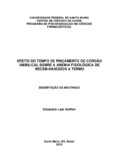| dc.creator | Steffen, Elizandra Leal | |
| dc.date.accessioned | 2013-05-21 | |
| dc.date.available | 2013-05-21 | |
| dc.date.issued | 2010-07-14 | |
| dc.identifier.citation | STEFFEN, Elizandra Leal. Effect of time of clamping of the umbilical cord on the phisiological anemy of newly-born babies. 2010. 85 f. Dissertação (Mestrado em Farmacologia) - Universidade Federal de Santa Maria, Santa Maria, 2010. | por |
| dc.identifier.uri | http://repositorio.ufsm.br/handle/1/5938 | |
| dc.description.abstract | This study verified the effect of late clamping (from 1 to 3 minutes after it is
born) of the umbilical cord on the levels of hemoglobin, hematocrite and ferritine in
children at birth, at three months and at six months and, still, the levels of bilirubins at
the end of the first week of life, in order to detect cases of hyperbilirrubinemia. One
hundred and eleven babies born at the University Hospital of santa Maria, RS, not
only by vaginal birth by also by caesarian surgery and clinically healthy were used
(45 ones were subjected to the early clamping and 66 ones to the late clamping). The
collect of venous blood of the babies on their first day was made in the maternity and,
the other collects were taken in returns to the laboratories of clinical analysis. The
mothers socio-economical variants and the babies nutritional habits were also
studied. the program Statsoft Statistica v 7.0.61.0EN was used to analyze the data
statistically and the results were expressed on their averages. The hemoglobine and
the hematocrite from the babies subjected to the late clamping were significantly
superior to the values presented by the babies subjected to the early clamping, on
their first day of life. There was no significant difference in the dosage of total bilirubin
and fractions of babies according to the time of clamping as well as there was no
case of hyperbilirrubinemia and the levels of ferritine of the children subjected to the
late clamping showed to be superior to the ones presented by those children
subjected to the early clamping in the third and in the sixth months. Thus, it is noticed
that the late clamping might be a strategy to prevent the anemia because of iron
defficiency in infants. | eng |
| dc.format | application/pdf | por |
| dc.language | por | por |
| dc.publisher | Universidade Federal de Santa Maria | por |
| dc.rights | Acesso Aberto | por |
| dc.subject | Pinçamento tardio | por |
| dc.subject | Cordão umbilical | por |
| dc.subject | Anemia | por |
| dc.subject | Late clamping | eng |
| dc.subject | Umbilical cord | eng |
| dc.title | Efeito do tempo de pinçamento do cordão umbilical sobre a anemia fisiológica de recém-nascidos a termo | por |
| dc.title.alternative | Effect of time of clamping of the umbilical cord on the phisiological anemy of newly-born babies | eng |
| dc.type | Dissertação | por |
| dc.description.resumo | Este estudo verificou o efeito do pinçamento tardio (de 1 a 3min após o
nascimento) do cordão umbilical sobre os níveis de hemoglobina, hematócrito e
ferritina em crianças no nascimento, aos três meses e aos seis meses e, ainda, os
níveis das bilirrubinas ao final da primeira semana de vida, para detectar casos de
hiperbilirrubinemia. Foram alocados 111 bebês a termo nascidos no Hospital
Universitário de Santa Maria, RS, tanto de parto vaginal quanto cesárea e
clinicamente saudáveis (45 foram submetidos ao pinçamento precoce e 66 ao
pinçamento tardio). A coleta de sangue venoso dos bebês no primeiro dia de vida foi
efetuada na maternidade e as coletas posteriores foram realizadas em retornos ao
laboratório de análises clínicas do hospital. Variáveis socioeconômicas da mãe e de
alimentação da criança também foram estudadas. Utilizou-se o programa Statsoft
Statistica v 7.0.61.0EN para a análise estatística dos dados e os resultados foram
expressos em média. A hemoglobina e o hematócrito dos bebês submetidos ao
pinçamento tardio do cordão umbilical foram significativamente superiores aos
valores apresentados pelos bebês submetidos ao pinçamento precoce, no primeiro
dia de vida. Não houve diferença significativa na dosagem da bilirrubina total e
frações dos bebês de acordo com o tempo de pinçamento, assim como, não houve
nenhum caso de hiperbilirrubinemia e os níveis de ferritina das crianças submetidas
ao pinçamento tardio mostraram-se superiores aos apresentados pelas crianças
submetidas ao pinçamento precoce no terceiro e no sexto mês. Assim, constatou-se
que o pinçamento tardio do cordão umbilical pode se constituir em uma estratégia
para prevenir a anemia por deficiência de ferro em lactentes. | por |
| dc.contributor.advisor1 | Silva, José Edson Paz da | |
| dc.contributor.advisor1Lattes | http://lattes.cnpq.br/1177504021154172 | por |
| dc.contributor.referee1 | Beck, Sandra Trevisan | |
| dc.contributor.referee1Lattes | http://lattes.cnpq.br/4435727183593265 | por |
| dc.contributor.referee2 | Spada, Celso | |
| dc.contributor.referee2Lattes | http://lattes.cnpq.br/5357991864400412 | por |
| dc.creator.Lattes | http://lattes.cnpq.br/7769599391901065 | por |
| dc.publisher.country | BR | por |
| dc.publisher.department | Farmacologia | por |
| dc.publisher.initials | UFSM | por |
| dc.publisher.program | Programa de Pós-Graduação em Ciências Farmacêuticas | por |
| dc.subject.cnpq | CNPQ::CIENCIAS BIOLOGICAS::FARMACOLOGIA | por |


